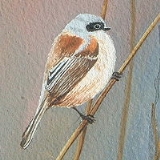
European Penduline Tit
Encyclopedia
The European Penduline Tit (Remiz pendulinus) is a passerine
of the genus
Remiz
. It is relatively widespread throughout Eurasia
.
The Asian (sub)species include the Black-headed Penduline Tit, Remiz macronyx, the White-crowned Penduline Tit, Remiz coronatus, and the Chinese Penduline Tit, Remiz consobrinus.
It builds an elaborate hanging nest, formerly used in Central Europe
as children's slippers.
This species was first described as Motacilla pendulinus by Linnaeus
in his Systema naturae in 1758.
Passerine
A passerine is a bird of the order Passeriformes, which includes more than half of all bird species. Sometimes known as perching birds or, less accurately, as songbirds, the passerines form one of the most diverse terrestrial vertebrate orders: with over 5,000 identified species, it has roughly...
of the genus
Genus
In biology, a genus is a low-level taxonomic rank used in the biological classification of living and fossil organisms, which is an example of definition by genus and differentia...
Remiz
Remiz
Remiz is a genus of birds in the Remizidae family, commonly known as the Eurasian pendulines...
. It is relatively widespread throughout Eurasia
Eurasia
Eurasia is a continent or supercontinent comprising the traditional continents of Europe and Asia ; covering about 52,990,000 km2 or about 10.6% of the Earth's surface located primarily in the eastern and northern hemispheres...
.
The Asian (sub)species include the Black-headed Penduline Tit, Remiz macronyx, the White-crowned Penduline Tit, Remiz coronatus, and the Chinese Penduline Tit, Remiz consobrinus.
It builds an elaborate hanging nest, formerly used in Central Europe
Central Europe
Central Europe or alternatively Middle Europe is a region of the European continent lying between the variously defined areas of Eastern and Western Europe...
as children's slippers.
This species was first described as Motacilla pendulinus by Linnaeus
Carolus Linnaeus
Carl Linnaeus , also known after his ennoblement as , was a Swedish botanist, physician, and zoologist, who laid the foundations for the modern scheme of binomial nomenclature. He is known as the father of modern taxonomy, and is also considered one of the fathers of modern ecology...
in his Systema naturae in 1758.

